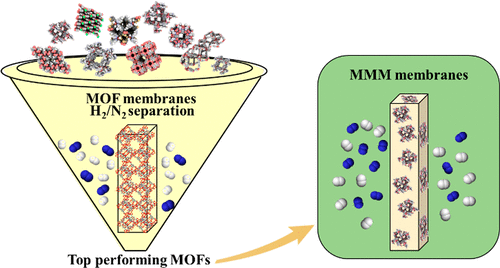当前位置:
X-MOL 学术
›
ACS Sustain. Chem. Eng.
›
论文详情
Our official English website, www.x-mol.net, welcomes your
feedback! (Note: you will need to create a separate account there.)
Large-Scale Computational Screening of Metal Organic Framework (MOF) Membranes and MOF-Based Polymer Membranes for H2/N2 Separations
ACS Sustainable Chemistry & Engineering ( IF 7.1 ) Pub Date : 2019-04-22 00:00:00 , DOI: 10.1021/acssuschemeng.9b01020 Ayda Nemati Vesali Azar 1 , Sadiye Velioglu 1 , Seda Keskin 1
ACS Sustainable Chemistry & Engineering ( IF 7.1 ) Pub Date : 2019-04-22 00:00:00 , DOI: 10.1021/acssuschemeng.9b01020 Ayda Nemati Vesali Azar 1 , Sadiye Velioglu 1 , Seda Keskin 1
Affiliation

|
Several thousands of metal organic frameworks (MOFs) have been reported to date, but the information on H2/N2 separation performances of MOF membranes is currently very limited in the literature. We report the first large-scale computational screening study that combines state-of-the-art molecular simulations, grand canonical Monte Carlo (GCMC) and molecular dynamics (MD), to predict H2 permeability and H2/N2 selectivity of 3765 different types of MOF membranes. Results showed that MOF membranes offer very high H2 permeabilities, 2.5 × 103 to 1.7 × 106 Barrer, and moderate H2/N2 membrane selectivities up to 7. The top 20 MOF membranes that exceed the polymeric membranes’ upper bound for H2/N2 separation were identified based on the results of initial screening performed at infinite dilution condition. Molecular simulations were then carried out considering binary H2/N2 and quaternary H2/N2/CO2/CO mixtures to evaluate the separation performance of MOF membranes under industrial operating conditions. Lower H2 permeabilities and higher N2 permeabilities were obtained at binary mixture conditions compared to the ones obtained at infinite dilution due to the absence of multicomponent mixture effects in the latter. Structure–performance relations of MOFs were also explored to provide molecular-level insights into the development of new MOF membranes that can offer both high H2 permeability and high H2/N2 selectivity. Results showed that the most promising MOF membranes generally have large pore sizes (>6 Å) as well as high surface areas (>3500 m2/g) and high pore volumes (>1 cm3/g). We finally examined H2/N2 separation potentials of the mixed matrix membranes (MMMs) in which the best MOF materials identified from our high-throughput screening were used as fillers in various polymers. Results showed that incorporation of MOFs into polymers almost doubles H2 permeabilities and slightly enhances H2/N2 selectivities of polymer membranes, which can advance the current membrane technology for efficient H2 purification.
中文翻译:

用于H 2 / N 2分离的金属有机骨架(MOF)膜和基于MOF的聚合物膜的大规模计算筛选。
迄今为止,已经报道了数千种金属有机骨架(MOF),但是关于MOF膜的H 2 / N 2分离性能的信息目前在文献中非常有限。我们报告了第一项大规模的计算筛选研究,该研究结合了最新的分子模拟,大经典蒙特卡洛(GCMC)和分子动力学(MD),以预测H 2的渗透性和H 2 / N 2的选择性3765不同类型的MOF膜。结果表明,MOF膜具有很高的H 2渗透性,2.5×10 3至1.7×10 6 Barrer和中等H 2 / N 2膜的选择性最高可达7。基于在无限稀释条件下进行初步筛选的结果,确定了超过H 2 / N 2分离聚合物膜上限的前20个MOF膜。然后考虑二元H 2 / N 2和四元H 2 / N 2 / CO 2 / CO混合物进行分子模拟,以评估MOF膜在工业操作条件下的分离性能。较低的H 2渗透率和较高的N 2由于在二元混合条件下无多组分混合效应,因此与在无限稀释下获得的渗透率相比,在二元混合条件下获得了渗透率。还研究了MOF的结构与性能之间的关系,从而为新型MOF膜的开发提供分子水平的见解,该膜可同时提供高H 2渗透性和高H 2 / N 2选择性。结果表明,最有前途的MOF膜通常具有大孔径(> 6Å),高表面积(> 3500 m 2 / g)和大孔体积(> 1 cm 3 / g)。我们终于检查了H 2 / N 2混合基质膜(MMM)的分离潜力,其中从我们的高通量筛选中识别出的最佳MOF材料被用作各种聚合物的填料。结果表明,将MOF掺入聚合物中几乎会使H 2的渗透率提高一倍,并略微提高聚合物膜的H 2 / N 2选择性,这可以推动当前的膜技术有效地纯化H 2。
更新日期:2019-04-22
中文翻译:

用于H 2 / N 2分离的金属有机骨架(MOF)膜和基于MOF的聚合物膜的大规模计算筛选。
迄今为止,已经报道了数千种金属有机骨架(MOF),但是关于MOF膜的H 2 / N 2分离性能的信息目前在文献中非常有限。我们报告了第一项大规模的计算筛选研究,该研究结合了最新的分子模拟,大经典蒙特卡洛(GCMC)和分子动力学(MD),以预测H 2的渗透性和H 2 / N 2的选择性3765不同类型的MOF膜。结果表明,MOF膜具有很高的H 2渗透性,2.5×10 3至1.7×10 6 Barrer和中等H 2 / N 2膜的选择性最高可达7。基于在无限稀释条件下进行初步筛选的结果,确定了超过H 2 / N 2分离聚合物膜上限的前20个MOF膜。然后考虑二元H 2 / N 2和四元H 2 / N 2 / CO 2 / CO混合物进行分子模拟,以评估MOF膜在工业操作条件下的分离性能。较低的H 2渗透率和较高的N 2由于在二元混合条件下无多组分混合效应,因此与在无限稀释下获得的渗透率相比,在二元混合条件下获得了渗透率。还研究了MOF的结构与性能之间的关系,从而为新型MOF膜的开发提供分子水平的见解,该膜可同时提供高H 2渗透性和高H 2 / N 2选择性。结果表明,最有前途的MOF膜通常具有大孔径(> 6Å),高表面积(> 3500 m 2 / g)和大孔体积(> 1 cm 3 / g)。我们终于检查了H 2 / N 2混合基质膜(MMM)的分离潜力,其中从我们的高通量筛选中识别出的最佳MOF材料被用作各种聚合物的填料。结果表明,将MOF掺入聚合物中几乎会使H 2的渗透率提高一倍,并略微提高聚合物膜的H 2 / N 2选择性,这可以推动当前的膜技术有效地纯化H 2。

































 京公网安备 11010802027423号
京公网安备 11010802027423号